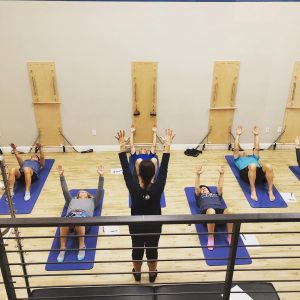6 Essential Habits that Build your Immunity
Flu season is upon us – and it’s that time of year where a healthy immune system is more important than ever. Whether it’s more shopping or extra Holiday gatherings, you’re bound to be around more people than usual, which is a recipe for spreading and catching germs.
Here are 6 essential habits that will help build your immunity:
1. Stay Hydrated
Staying hydrated is one of the best things you can do for your health all of the time, but it’s especially important when you’re trying to fight disease. Water helps flush everything out, and your cells (especially those that fight germs) work better when fully hydrated. But water isn’t the only thing that helps you stay hydrated. Broth, tea, or anything without a lot of sugar counts. Personally, when I’m not feeling well, I love making myself a big thermos of hot water with lemon and tea. Not only is it soothing but it’s packed with vitamin C. So how much water should you drink? The U.S. National Academies of Sciences, Engineering, and Medicine says that men should aim for about 15.5 cups per day, while women should aim for 11.5 cups. Now keep in mind, how much you exercise and sweat each day will vary these numbers, but as a general rule, keep your favorite water bottle by your side at all times and make staying hydrated easy.
2. Exercise Regularly
Exercising regularly is well-known for improving cardiovascular health, lowering blood pressure, keeping muscles and bones strong, and helping control your body weight. But did you know that regular exercise also helps you boost your immune system? There are a certain amount of immune cells naturally circulating through your body at all times. But when you exercise, and increase your blood flow, you help push more immune cells from your lymph nodes and spleen into your bloodstream. Now if you’re already sick or feeling low energy, it’s important to listen to your body and modify where you need to. You don’t want to risk getting an injury for the sake of your immune system. There has to be a balance. But going for an easy walk – even when you’re sick – can help. And when you’re not sick – get moving – it’s going to help build a healthy immune system not to mention a healthy musculoskeletal system.
3. Get some Sleep
Good, quality sleep is essential for your health, and it helps keep your immune system functioning well. When we sleep, our bodies produce special proteins designed to target infection and inflammation, and T-cells (white blood cells) that play a critical role in fighting infectious diseases. So what happens when we don’t sleep? Lack of sleep has been proven to increase the risk of illness. Sleep researchers at several universities tested this theory by exposing 164 volunteers to the cold virus through nasal drops while monitoring their sleep and evaluating their health habits. The participants who slept less than five hours were four-and-a-half times more likely to catch a cold than those who slept for seven hours a night. So prioritizing sleep is crucial all of the time – but especially when you’re fighting off a cold or illness.
4. Eat Well
Eating a healthy, whole-food and varied diet is one of the best ways to boost your immune system. Incorporating vibrant fruits and vegetables bursting with vitamins and antioxidants, such as citrus fruits, bell peppers, spinach, and berries, will bolster your body’s ability to fight off infections. Lean proteins like poultry and fish, along with probiotic-rich foods such as yogurt and kimchi, support a healthy gut, which happens to be where a significant portion of your immune system resides. And don’t forget about whole grains and healthy fats – like those found in nuts and olive oil. They help strengthen your immune system also. Eating well is good for you all the time – but especially when you’re sick and trying to fight off germs and infection.
5. Be Social
Having positive interactions with people and meaningful relationships is not only linked to improved immunity, but it also happens to top the list of things that help us to live longer. Now, if you’re already sick, then you may want to stay away from your friends and loved ones physically. That doesn’t mean you can’t pick up the phone or hop on Zoom. But when you’re feeling good and healthy – prioritize these relationships and connections. Make time for group activities, or walks with a friend. Being social and interacting with others contributes positively to your emotional well-being – and turns out – will help keep you from getting sick as well.
6. Get Outside
Getting a regular dose of fresh air not only reduces stress, but it gives you vitamin D. You can get vitamin D from food and supplements – but the best place to get it is from the sun. The effectiveness of vitamin D on fighting colds and flus is still unclear and being studied, but vitamin D is believed to help facilitate a healthy and normal immune system. But regardless of the research, getting outside feels good and gets you away from all that circulated air indoors. I don’t think it’s a coincidence that we get more colds in the winter, so when you can, bundle up and get outside. Your immune system will actually thank you.
Having a strong immune system keeps us healthy. And when we’re healthy, we can take that opportunity to work on and optimize other aspects of our health – such as strength, mobility, and cardiovascular health – that keep us feeling good and reduce our risk of injury. Getting sick puts a stop to life’s momentum, and can prevent you from getting into a routine altogether if you’re getting sick often. So don’t take your health for granted. If you haven’t already, start incorporating one or more of these habits into your life today.
Dr. Carrie Jose, Physical Therapist and Pilates expert, owns CJ Physical Therapy & Pilates in Portsmouth and writes for Seacoast Media Group. To get in touch, email her at [email protected].














